|
Jewel Cave National Monument is home to several species of birds throughout the year. Hiking trails on the surface give birders a wonderful opportunity to view a diverse selection of birds from red-headed woodpeckers along the Canyons Trail, to the white-breasted nuthatch on the Roof Trail. Depending on the time of day and year you chose to visit Jewel Cave, you can always find some feathered friends flying about. The most commonly seen birds are listed below. To see a full list of the species found at Jewel Cave, visit NPSpecies.
Year Round Residents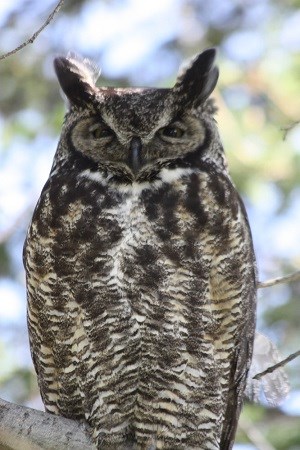
NPS Photo / Robbie Hannawacker Great Horned Owl (Bubo virginianus)Known for their ear tuffs, the Great Horned Owl is one of North America’s largest owls. Living across the entirety of the United States, they vary in color by geographic region. At the monument, they showcase a pale grayish color and the typical bright yellow eyes. Usually heard and not seen, you may hear their classic hoo hoo HOO hoo hoo. 
NPS Photo / Gary Hartley Black-Capped Chickadee (Poecile atricapillus)Along with its gray back and white/tan underbelly, this small songbird was named for its distinctive black cap and white cheeks. Black-capped chickadees are commonly seen at the monument hopping between small tree branches and foraging for insects on the bark surface. Much like squirrels, these birds store seeds in several different locations and later return to them. 
NPS Photo White-Breasted Nuthatch (Sitta carolinensis)Commonly referred to as “upside down birds”, nuthatches display the unique behavior of moving up and down vertical surfaces headfirst. The white-breasted nuthatch is the largest nuthatch species at the monument and is characterized by a gray-blue back, white underbelly, and black cap (gray in females) that resembles a hood. This species can be found foraging up and down the pine trees at the monument. 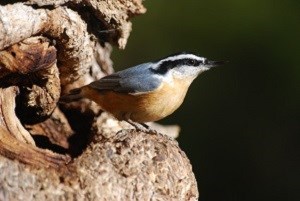
NPS Photo Red-Breasted Nuthatch (Sitta canadensis)Similar in appearance to the white-breasted nuthatch, this species is distinguished by a rust-colored underbelly. The red-breasted nuthatch additionally has a broad, black eye line with a white line directly above it. These birds may be seen collecting resin from ponderosa pines and plastering it around the entrance to their nesting holes. 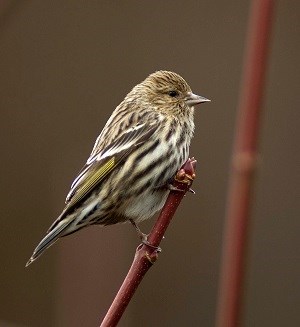
NPS Photo Pine Siskin (Spinus pinus)Although they can be seen year-round in the Black Hills, the pine siskin only inhabits the remainder of South Dakota during the non-breeding season (fall or winter). Small, they have a sharp bill and notched tail. The brown body is streaked with yellow feathers, but the head remains brown. They are mostly seen in pine trees or foraging for seeds. 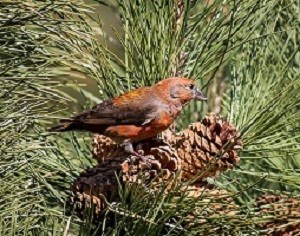
NPS Photo / Larry Putnam Red Crossbill (Loxia curvirostra)Known for their distinctly crossed bills, the crossbill is excellent at foraging conifer seeds. Found in trees, males and females differ in color. Adult males showcase a bright red body with hints of brown on their wings. In contrast, females have a yellow body with brown wings. 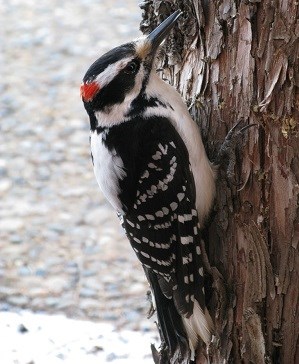
NPS Photo / Nathan King Hairy Woodpecker (Dryobates villosus)Similar in appearance to the downy woodpecker, the hairy woodpecker is larger in size with a longer bill used for excavating in trees. Males and females both have a white stripe down the middle of their back and rows of white spots on their wings. Males can be distinguished from females via the red patch on the back of their head. 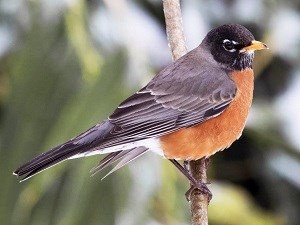
NPS Photo American Robin (Turdus migratorius)A common backyard resident across most of North America, robins are a familiar sight to most visitors at Jewel Cave. These birds are distinguished by a dark back, a rusty orange breast, and a white throat with dark stripes. They are commonly seen running and hopping along the Roof Trail as well as around the outskirts of the parking lot at the monument. 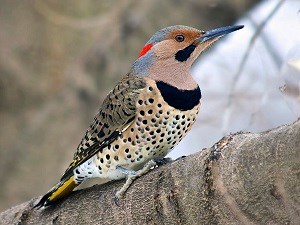
NPS Photo Northern Flicker (Colaptes auratus)Unlike many woodpeckers, northern flickers forage for most of their food on the ground and are often seen poking around fallen pine needles at the monument. These birds are distinctly patterned with a black-striped back, black-spotted breast, and black chest patch. Males additionally have a distinctive red facial marking. The monument is home to both red-shafted and yellow-shafted northern flickers, subspecies that differ slightly in coloration. 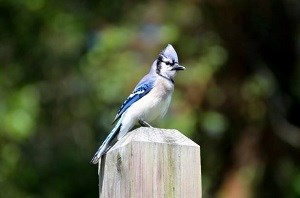
NPS Photo Blue Jay (Cyanocitta cristata)Common throughout the Midwest, South, and Eastern United States, the blue jay is usually heard before seen. Their most common vocalization is a jeer, a high-pitched scream that is often repeated. Blue feathers cover their crest, back and tail, while white cover their stomach and breast. Spring and Summer Residents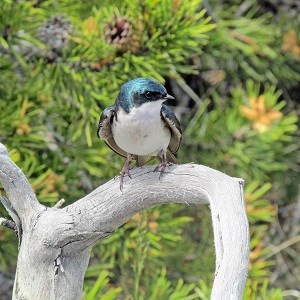
NPS Photo Tree Swallow (Tachycineta bicolor)Easily identified by their iridescent blue backs and white underbellies, tree swallows can be seen diving and gliding above Canyons Trail. Although these birds hunt for insects in open habitat, they are named for their tendency to roost within tree cavities. Female tree swallows are duller in color than males, but both sexes have a notched tail. In the spring and fall, these birds migrate in large flocks by the thousands. 
NPS Photo / Jacob W. Frank Cliff Swallow (Petrochelidon pyrrhonota)Where one cliff swallow is spotted, many others are likely nearby. These birds commonly flock in large groups and build colonies of mud nests on vertical surfaces, including the cliffs along Hell Canyon. Cliff swallows are characterized by a dark blue back, pale orange rump, and white underbelly. They additionally have a dark orange chin and a white forehead patch. Seen from below, this species can be distinguished from all other swallows at the monument by their square tail. 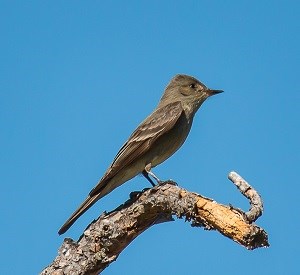
NPS Photo / Larry Putnam Western Wood-Peewee (Contopus sordidulus)With a gray-brown back and white underbelly, the western wood-peewee can be difficult to distinguish from other flycatchers in the Black Hills. They are most easily identified by their white wing bars and lack of an eye ring. Commonly heard before seen, western wood-peewees are typically among the last songbirds to stop singing in the evening. These birds are most frequently spotted in open woodlands, and visitors may hear them clapping their bill as they defend their nest from predators. 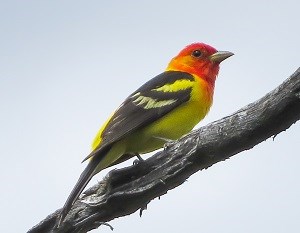
NPS Photo / Ingrid Arlton Western Tanager (Piranga ludoviciana)Among the most colorful birds found at the monument, western tanagers are easily identified by their bright yellow body, dark wings, and strong white wing bars. Additionally, males have a scarlet head. These birds are most commonly seen in the pine forest surrounding the monument’s visitor center. The Black Hills are situated along the easternmost summer range of the western tanager. 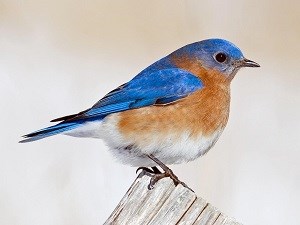
NPS Photo Eastern Bluebird (Sialia sialis)Sexually dimorphic, males are bright blue across their head, wings, and back, compared to females. This bright blue shines in contrast to the rusty color of their chest and throat. While females show blue and rusty coloration, it will be muted and have hints of gray blended on their head and back. 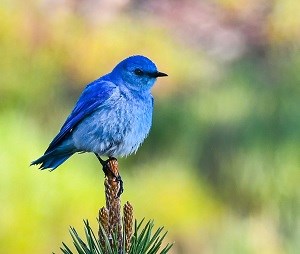
NPS Photo / Jane Gamble Mountain Bluebird (Sialia currucoides)The striking blue coloration of mountain bluebird sharply contrasts against the green and brown of the ponderosa pines. Males appear sky-blue, but most vibrant on their head, back and wings. Females and juveniles are gray with hints of brown, but blue shows on their wings and tail. Most commonly they are found nesting in tree cavities excavated by local woodpeckers. 
NPS Photo Spotted Towhee (Pipilo maculatus)Commonly found on the ground searching through leaf litter for food, males and females showcase a slight color variation. Large sparrows with a long tail, males have a black head, throat, and upperparts, while females have a brown head, throat and upperparts. Both males and females have a white belly and white spots along their wings and back. 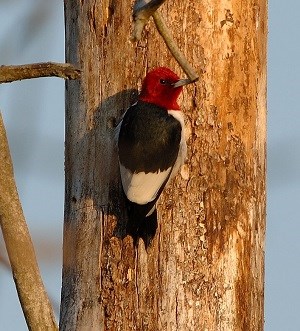
NPS Photo Red-Headed Woodpecker (Melanerpes erythrocephalus)Rarely seen in winter, but common in summer, the red-headed woodpecker has a red head, neck, and throat. Distinct against their red feathers, you will see a white chest and black back. The wings are black with a large white patch on each, but when in flight or perched, the white shows as a band. Males and females do not differ in coloration, but juveniles have a brown head. 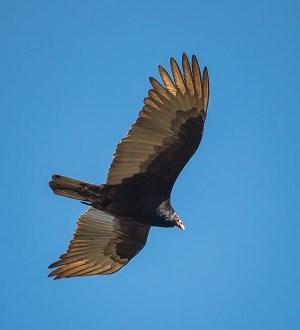
NPS Photo / Larry Putnam Turkey Vulture (Cathartes aura)Known for their bald red heads, these large birds commonly soar high in the sky riding thermal air currents. Although red, their legs can appear white if the bird urinates on itself to thermoregulate. When observed from below, you will see two-toned underwings and possibly their ivory bill. When not soaring, they are usually found feeding on carrion. Fall and Winter Residents
NPS Photo Townsend’s Solitaire (Myadestes townsendi)Seen in the non-breeding season, the most prominent feature of this mid-sized thrush is their white eye ring. Gray in color, small patches of copper show on their wings. Juveniles appear dark gray, speckled with copper and white spots, giving the appearance of scales. During the winter months, both males and females are known for being extremely territorial and switching their diet from insects to berries. |
Last updated: July 25, 2021
